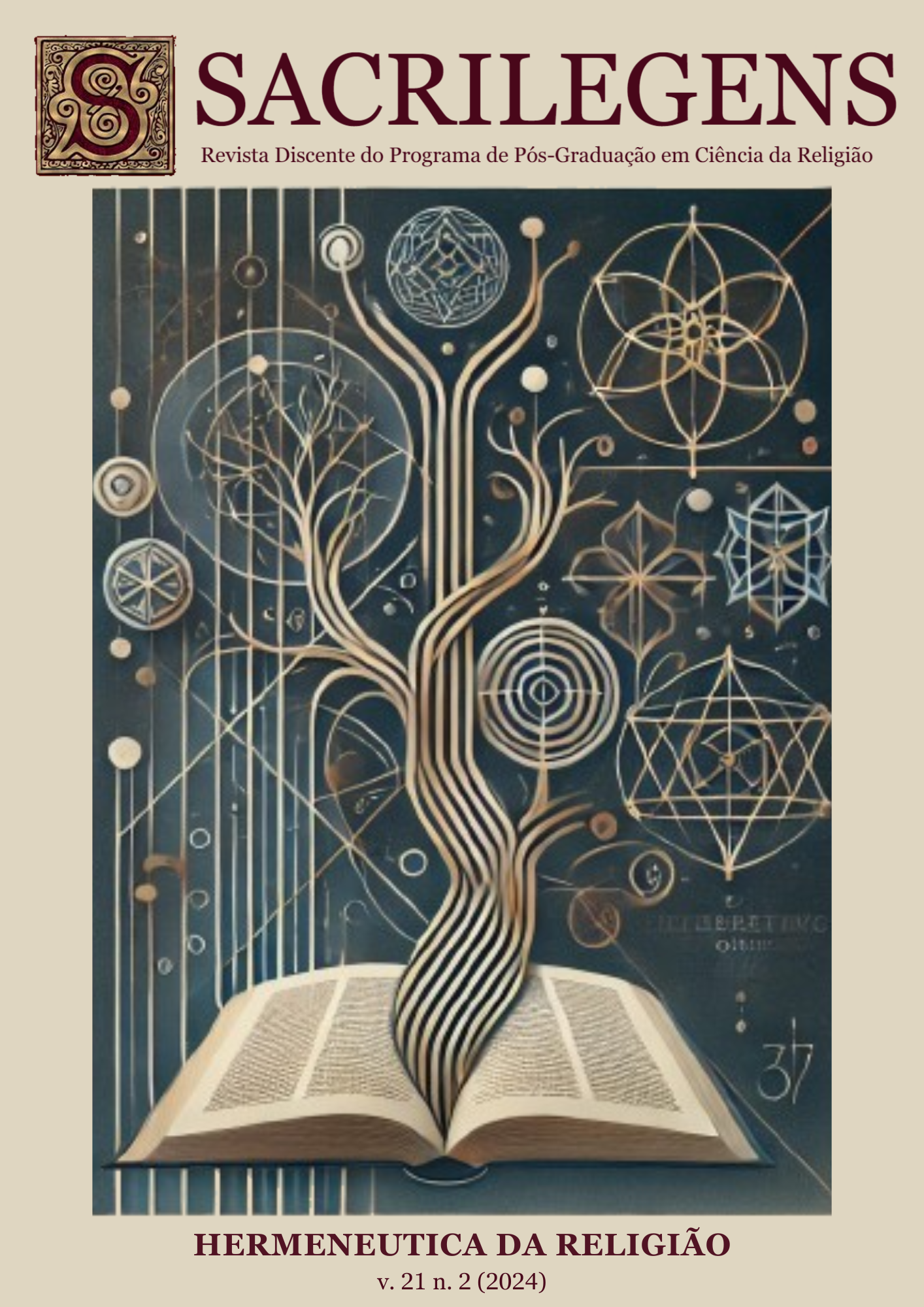“I am not the wife of Lucifér, I am his mother”:
Motherhood, gender, witchcraft, and femininity are the fruits of Pombagira Dona Figueira.
DOI:
https://doi.org/10.34019/2237-6151.2024.v21.45706Keywords:
Pombagira. Umbanda. Motherhood. Witchcraft.Abstract
Umbanda is a hybrid religion that combines elements from different sources and is mainly characterized by its colorful palette of spirits, among which Exu and his female counterpart: Pombagira stand out. The relationship between Pombagira and Umbanda necessarily involves its unmistakable association with the feminine as something dangerous, free and that does not lend itself to social conventions. However, the plasticity of Pombagira cannot be restricted. During a visit to the Centro Espírita Estrela Guia (Tijuca, Rio de Janeiro/RJ), the head of the house, Pombagira Dona Figueira, showed her maternal side in an interview, subverting the most ordinary expectations about the imaginary of Pombagira. This article reflects on the notion of Pombagira in Umbanda and Quimbanda, following the revelations of Dona Figueira, which are surprisingly and complexly intertwined with Catholic elements, witchcraft and Brazilianness.
Downloads
References
AGRA, M. F., BARACHO, G. S, NURIT, K, et al. Medicinal and poisonous diversity of the flora of “Cariri Paraibano”, Brazil. Journal of Ethnopharmacology, v, 111 (2), p. 383-395. 2007. https://doi.org/10.1016/j.jep.2006.12.007.
AUGRAS, M. De Iyá mi a pomba-gira: transformações e símbolos da libido. In: MOURA, Carlos Eugênio Marcondes (org.) Candomblé: religião do corpo e da alma: tipos psicológicos nas religiões afro-brasileiras. Rio de Janeiro: Pallas, 2000. p. 17-44.
BARROS, S.C. As entidades “brasileiras” da Umbanda e as faces inconfessas do Brasil. XXVII Simpósio Nacional de História: Conhecimento histórico e diálogo social, Anais eletrônicos, Natal, RN, 22 a 26 de Julho de 2013. URL: http://www.snh2013.anpuh.org/resources/anais/27/1364315430_ARQUIVO_AsEntidadesBrasileirasdaUmbandaeasFacesInconfessasdoBrasilSimposioANPUH.pdf
CASTAÑEDA, C. A erva do diabo. São Paulo, Editora Bestseller, 2013.
DE BARROS, C. A. Iemanjá e pomba-gira: imagens do feminino na umbanda. Dissertação. Programa de pós-graduação em Ciência da Religião. Universidade Federal de Juiz de Fora. 2006.
DE HEUSCH Luc, « Pour une approche structuraliste de la pensée magico-religieuse bantoue », dans : , Pourquoi l'épouser ?sous la direction de DE HEUSCH Luc. Paris, Gallimard, « Bibliothèque des sciences humaines », p. 170-188, 1971. URL : https://www.cairn.info/pourquoi-l-epouser--9782070277575-page-170.htm
DOS SANTOS, N. L. Queimem a bruxa!: o controle de corpos e sexualidades da caça às bruxas à ideologia de gênero. Dissertação. Programa de pós-graduação em Relações Internacionais. Pontifícia Universidade Católica do Rio de Janeiro. 2021.
FERNANDES, S. C. Cultos híbridos no que é afro-brasileiro: qual a fronteira entre Umbanda, Quimbanda e Candomblé? Anais dos simpósios da ABHR. 2012. URL: https://revistaplura.emnuvens.com.br/anais/article/view/669/557
HESS, D. J. Umbanda and Quimbanda Magic in Brazil: Rethinking Aspects of Bastide's Work. Archives de sciences sociales des religions, 37(79), 135–153. 1992. doi:10.2307/30128587
JURKEVICS, V. I. Virgem Maria: paradigma da “superioridade espiritual feminina”. Fazendo Gênero 9: Diásporas, Diversidades, Deslocamentos. Anais eletrônicos. 23 a 16 de agosto de 2010. URL: https://www.fg2010.wwc2017.eventos.dype.com.br/resources/anais/1276543954_ARQUIVO_VIRGEMMARIAParadigmadasuperioridadeespiritualfeminima.pdf
LAGES, S. R. C. & D'ÁVILA, M. I. Vida cigana: mulheres, possessão e transgressão no terreiro de Umbanda. Pesquisas e Práticas Psicossociais. 2 (1), p.12-17, São João del-Rei, Mar-Ago2007.
MUKHTAR, Y., TUKUR, S., & BASHIR, R. A. . An Overview on Datura stramonium L. (Jimson weed): A Notable Psychoactive Drug Plant. American Journal of Natural Sciences, 2(1), 1 - 9. 2019. https://doi.org/10.47672/ajns.423
NEGRÃO, L. N. (1993). Umbanda: entre a cruz e a encruzilhada. Tempo Social, 5(1/2), 113-122. https://doi.org/10.1590/ts.v5i1/2.84951
OGUNLEYE, A. R. Cultural identity in the throes of modernity: an appraisal of Yemoja among the Yoruba in Nigeria. Inkanyiso, Jnl Hum & Soc Sci, 7(1), p.60-68. 2015.
PRANDI, R. Pombagira e as faces inconfessas do Brasil. Estudos Afro-Brasileiros, v. 3, n. 1, p. 79-132, 8 ago. 2022.
REYNOLDS, B. K. The Virgin and the Lady: Some Considerations on the Intersections between Courtly and Marian Literature. Wenshan Review of Literature and Culture, vol 7.2, p. 229-277. 2014.
SÁ JUNIOR, M. T. A invenção do Brasil no mito fundador da Umbanda. Revista Eletrônica História em Reflexão, v.6, n. 11, 2012.
VARGAS, E. P. (1999). A figueira do inferno: os reveses da identidade feminina. Revista Estudos Feministas, 89. https://doi.org/10.1590/%x
Downloads
Published
How to Cite
Issue
Section
License
Copyright (c) 2025 Eduardo Regis

This work is licensed under a Creative Commons Attribution 4.0 International License.
 Sacrilegens is licensed under a Creative Commons Attribution 4.0 International License.
Sacrilegens is licensed under a Creative Commons Attribution 4.0 International License.










